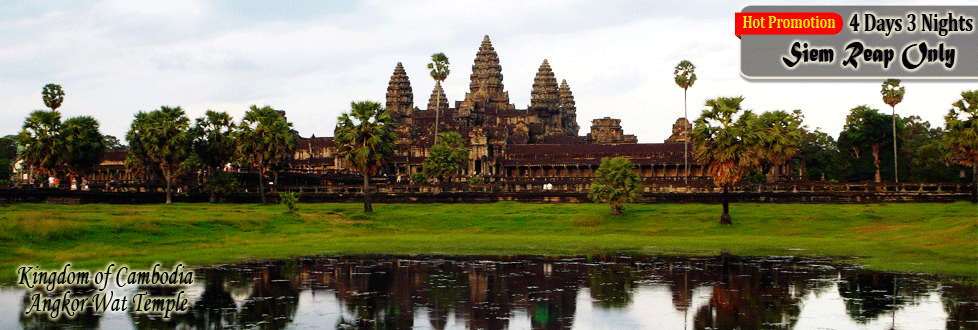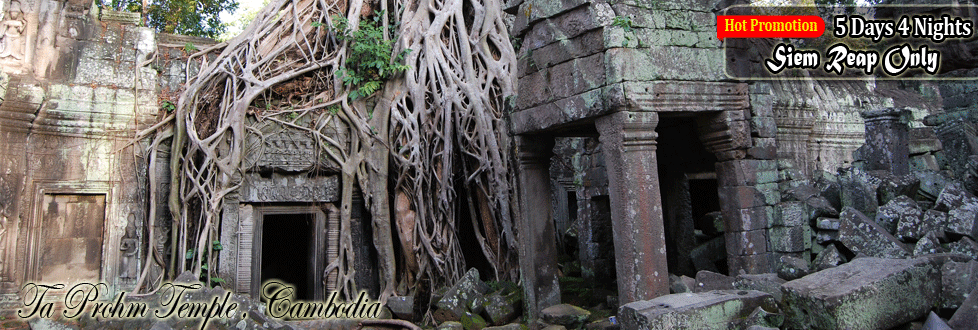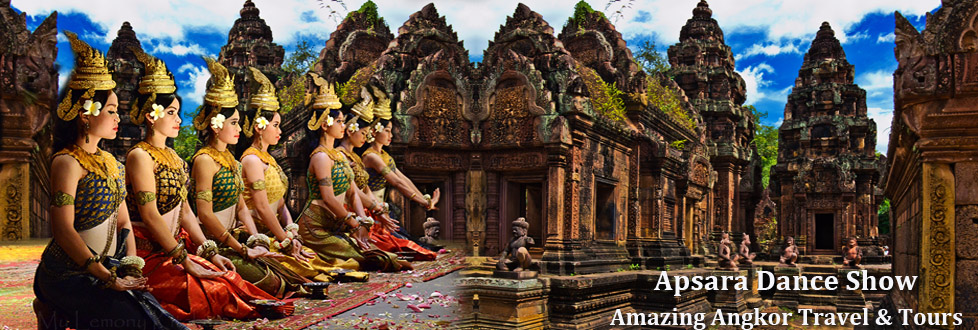I.Food and Drinks in Cambodia

 Cambodian cuisine, though uniquely Khmer, draws heavily on the traditions of both its Thai neighbors and Chinese residents. An oft-repeated generalization which is, nevertheless pretty accurate, likens Cambodian food to Thai food but without the spiciness. The main national staple is of course rice, but French colonial influence has dictated that the Cambodians eat more bread--generally French-style baguettes--than any other Southeast Asian country. Because of the country's incredible richness in waterways including the Mekong, Ton Le Sap and Ton Le Bassac Rivers, not to mention the Tonlé Sap Lake, freshwater fish and prawns are especially popular--in addition to which plenty of fresh seafood is available from the Gulf of Thailand. Beef, pork, chicken, duck and other poultry are widely available but generally more expensive than fish dishes, whilst other less well known Cambodian delicacies include locusts, field rats, snakes and land crabs.
Cambodian cuisine, though uniquely Khmer, draws heavily on the traditions of both its Thai neighbors and Chinese residents. An oft-repeated generalization which is, nevertheless pretty accurate, likens Cambodian food to Thai food but without the spiciness. The main national staple is of course rice, but French colonial influence has dictated that the Cambodians eat more bread--generally French-style baguettes--than any other Southeast Asian country. Because of the country's incredible richness in waterways including the Mekong, Ton Le Sap and Ton Le Bassac Rivers, not to mention the Tonlé Sap Lake, freshwater fish and prawns are especially popular--in addition to which plenty of fresh seafood is available from the Gulf of Thailand. Beef, pork, chicken, duck and other poultry are widely available but generally more expensive than fish dishes, whilst other less well known Cambodian delicacies include locusts, field rats, snakes and land crabs.

 Soup is served as an accompaniment to almost all Cambodian meals, though it is always served with the main dishes, not before as in the West. Some of the better-known soup dishes include Somlar Machou Banle (Sour fish soup), Somlar Machou Bangkang (Sour and spicy prawn soup, akin to Thai tom yam gung), Somlar chapek (Pork soup with ginger) and Mon sngor (chicken and coriander soup). Num Banh Choc (Rice noodle and fish soup) is a common and popular Cambodian breakfast.
Soup is served as an accompaniment to almost all Cambodian meals, though it is always served with the main dishes, not before as in the West. Some of the better-known soup dishes include Somlar Machou Banle (Sour fish soup), Somlar Machou Bangkang (Sour and spicy prawn soup, akin to Thai tom yam gung), Somlar chapek (Pork soup with ginger) and Mon sngor (chicken and coriander soup). Num Banh Choc (Rice noodle and fish soup) is a common and popular Cambodian breakfast.
++Rice and fish are the basic foods enjoyed by Cambodians. Delicious noodle soups are available at cafes. Fresh seafood is plentiful at Sihanouk Ville. In major cities a wide range of culinary fare is on offer including; Chinese, Thai, French, Korean, Japanese, Indian, Vietnamese and Middle Eastern. The Cambodian food combines Chinese and Indian influences with its own; native recipes. Most famous are the curries and the spicy hot seasoned stews, plus the smooth and tasty coconut curries. Most meals use rice as the filler, but there are many noodle dishes: and salads without rice. Ovens are not part of the ordinary Cambodian kitchen or small restaurant, for cooked food is either boiled or stir-fried. Cambodian food is never bland. Its range of spices includes chili, pepper, coriander leaf and root, lemon grass, basil, ginger, mint, cardamom, and screw pine. Sour soups are popular and meat and fish are always served with sauces like shrimp paste, tamarind, or honey with chili. Fish sauce is the basic substitute for salt across the country. Spicy salads are a local specialty. They are made from raw prawns, meat, green papaya, field crab, or chopped raw meat, with chili and other spices. Like the various noodle dishes, they are often sold at street side stalls for those who want a light meal. Cambodian have no food bias and are always willing to try any sort of meat, wild or domestic, and most seafood.
++A Traditional Meal
Before Western influence introduced tables and chairs, Cambodian dined by sitting on the floor around a small, short table. Various curries and other dishes were set upon the table, like cabbage and green bean, skewered or fried meat, crab or fish. The hot, sour soup that is part of any full-course Cambodian meal was cooked in clay pot that was placed in the center of the table. Rice was served in small bowls to each person, who then used spoons or chopsticks to select pieces of food from the other bowls. Each dinner also had a separate soup bowl that he or she filed from the common pot. That ancient style of eating has not changed much; the only exception is that the food has been transferred to a taller table. Soup is still cooled in the center, if not in a clay pot then in a wheel-shaped pan. But throughout the countryside, the old my still exist.
++Rice
Several months of hard labor go into providing Cambodian supper tables with their most important food-rice. Farmers have to break up the hard ground during the dry season of the year and plough it with the first drops of rain. Rice seedlings are first planted in one part of the field, where they grow while the farmer cultivates and prepares another part of the field in which the rice will be transplanted at the start of the heavy rain season. Weeds and pests attack the rice fields all summer. Hoppers, rice bugs, field crabs, mice, and herons keep the farmers busy. After the rains comes the harvest, followed by the exhausting job of threshing, winnowing, and milling the rice grains. Most Cambodian prefers the highly polished variety called Angkor laar, or “beautiful rice.”
++Nonalcoholic Drinks
All the famous international brands of soft drinks are available in Cambodia. Locally produced mineral water is available at 500r to 700r per bottle. Coffee is sold in most restaurants. It is either served black or with generous dollops of condensed milk, which makes it very sweet. Chinese-style tea is popular and in many Khmer and Chinese restaurants a pot of it will automatically appear as soon as you sit down. You can find excellent fruit smoothies all over the country, known locally as a tikalok. Just look out for a stall with fruit and a blender and point to the flavors you want. Keep an eye on the preparatory stages or you may end up with heaps of sugar and a frothy egg. On a hot day you may be tempted by the stuff in Fanta bottles on the side of the road. Think again, as it is actually petrol (gas).
Fruit
There is an abundance of fruit in Cambodia. In the appropriate seasons--especially towards the end of the hot season in May--the markets overflow with a wide variety of exotic fruits. There's fruit to be had the year round, though, and it's generally both reasonably priced and (if carefully washed) healthy and safe. Amongst the most popular and widespread fruits are mango, coconut, rambutan, durian, mangosteen, starfruit, pineapple, watermelon and a wide variety of bananas
++Alcoholic Drinks
 The local bee is Angkor, which is produced by an Australian joint venture in Sihanoukwille. Other brands include Heineken, Tiger, San Miguel, Carlsberg, VB, Foster's and Grolsch. Beer sells for around US$1 to US$1.50 a can in restaurants. In Phnom Penh, foreign wines and spirits are sold at reasonable prices. The local spirits are best avoided, though some experts say that Sra Special, a local whisky-like concoction, is not bad. At around 1000r a bottle it's a cheap route to oblivion.
The local bee is Angkor, which is produced by an Australian joint venture in Sihanoukwille. Other brands include Heineken, Tiger, San Miguel, Carlsberg, VB, Foster's and Grolsch. Beer sells for around US$1 to US$1.50 a can in restaurants. In Phnom Penh, foreign wines and spirits are sold at reasonable prices. The local spirits are best avoided, though some experts say that Sra Special, a local whisky-like concoction, is not bad. At around 1000r a bottle it's a cheap route to oblivion.
Other common dishes include Khao Poun (Rice noodles in a coconut-based sauce), Amok (fish with coconut milk steamed in a banana leaf), Sach Mon Chha Khnhei (stir-fried chicken with ginger), Somlar Machou Sachko (Sour beef stew) and Choeeng Chomni Chrouc Chean (Fried pork spareribs). An Sam Chruk (Pork & soybeans marinated in ginger and chili) can be delicious, but packs a fairly hefty punch. Similarly watch out for Pong Tea Kon (Fertilized duck egg containing an embryo, like the Filipino balut) which is not to everybody's taste. Many dishes are served Trey, or grilled. Thus Trey Aing (Grilled fish) is available just about everywhere, as is trey Chean Neung Spey (fried fish with vegetables). By extension, Trey Mon is grilled chicken, Trey Sachko is grilled beef, and so on. Fish and meat dishes not served with noodles are generally accompanied by rice. Indispensable condiments--certainly as far as the Cambodians are concerned--are Prahoc (fish sauce just like Thai Nam Pla and Vietnamese Nuoc Mam) and Tuk Trey (fish sauce with ground, roasted peanuts added).
Travelers up country will generally find themselves limited to Cambodian cuisine or to the fairly ubiquitous baguette and paté. In towns of any size--all provincial capitals, for example--Chinese food is widely available, generally reflecting the southern coastal origin of most of Cambodia's Overseas Chinese migrants. Expect, therefore, Cantonese, Hokkien, Teochou and Hailam fare, but don't waste your time looking for Szechuan or Yunnanese cuisine. In the west of the country, notably at Poipet, Sisophon, Battambang and Siem Reap, Thai cuisine is widespread. Similarly in the east, at Kampot, Takeo, Kompong Cham and Svay Rieng, Vietnamese culinary influence is common. Sihanoukville excels at seafood cooked in every conceivable way, and also has a fast growing smattering of Western food outlets--French, Italian, British, German and Australian.
Phnom Penh has, naturally enough, the widest range of restaurants in the city. Here the visitor can find everything listed above as well as Greek, Turkish, North Indian, South Indian, Malay and-increasingly--'Fast Food' restaurants. The capital also serves some of the best French food available in Indochina, as well as some unexpected colonial hangovers from the Middle East and North Africa, notably couscous and merguez spicy Moroccan sausage. Pizza is increasingly popular, but the 'Pizza Hut' restaurant near the Cambodia-Vietnam Friendship Monument is, at time of writing, a copycat operation.




.jpg)
.jpg)
.jpg)

.jpg)
.jpg)
.jpg)

.gif)

 Cambodia Visa & Passport
Cambodia Visa & Passport 



 Cambodian cuisine, though uniquely Khmer, draws heavily on the traditions of both its Thai neighbors and Chinese residents. An oft-repeated generalization which is, nevertheless pretty accurate, likens Cambodian food to Thai food but without the spiciness. The main national staple is of course rice, but French colonial influence has dictated that the Cambodians eat more bread--generally French-style baguettes--than any other Southeast Asian country. Because of the country's incredible richness in waterways including the Mekong, Ton Le Sap and Ton Le Bassac Rivers, not to mention the Tonlé Sap Lake, freshwater fish and prawns are especially popular--in addition to which plenty of fresh seafood is available from the Gulf of Thailand. Beef, pork, chicken, duck and other poultry are widely available but generally more expensive than fish dishes, whilst other less well known Cambodian delicacies include locusts, field rats, snakes and land crabs.
Cambodian cuisine, though uniquely Khmer, draws heavily on the traditions of both its Thai neighbors and Chinese residents. An oft-repeated generalization which is, nevertheless pretty accurate, likens Cambodian food to Thai food but without the spiciness. The main national staple is of course rice, but French colonial influence has dictated that the Cambodians eat more bread--generally French-style baguettes--than any other Southeast Asian country. Because of the country's incredible richness in waterways including the Mekong, Ton Le Sap and Ton Le Bassac Rivers, not to mention the Tonlé Sap Lake, freshwater fish and prawns are especially popular--in addition to which plenty of fresh seafood is available from the Gulf of Thailand. Beef, pork, chicken, duck and other poultry are widely available but generally more expensive than fish dishes, whilst other less well known Cambodian delicacies include locusts, field rats, snakes and land crabs.
 Soup is served as an accompaniment to almost all Cambodian meals, though it is always served with the main dishes, not before as in the West. Some of the better-known soup dishes include Somlar Machou Banle (Sour fish soup), Somlar Machou Bangkang (Sour and spicy prawn soup, akin to Thai tom yam gung), Somlar chapek (Pork soup with ginger) and Mon sngor (chicken and coriander soup). Num Banh Choc (Rice noodle and fish soup) is a common and popular Cambodian breakfast.
Soup is served as an accompaniment to almost all Cambodian meals, though it is always served with the main dishes, not before as in the West. Some of the better-known soup dishes include Somlar Machou Banle (Sour fish soup), Somlar Machou Bangkang (Sour and spicy prawn soup, akin to Thai tom yam gung), Somlar chapek (Pork soup with ginger) and Mon sngor (chicken and coriander soup). Num Banh Choc (Rice noodle and fish soup) is a common and popular Cambodian breakfast. The local bee is Angkor, which is produced by an Australian joint venture in Sihanoukwille. Other brands include Heineken, Tiger, San Miguel, Carlsberg, VB, Foster's and Grolsch. Beer sells for around US$1 to US$1.50 a can in restaurants. In Phnom Penh, foreign wines and spirits are sold at reasonable prices. The local spirits are best avoided, though some experts say that Sra Special, a local whisky-like concoction, is not bad. At around 1000r a bottle it's a cheap route to oblivion.
The local bee is Angkor, which is produced by an Australian joint venture in Sihanoukwille. Other brands include Heineken, Tiger, San Miguel, Carlsberg, VB, Foster's and Grolsch. Beer sells for around US$1 to US$1.50 a can in restaurants. In Phnom Penh, foreign wines and spirits are sold at reasonable prices. The local spirits are best avoided, though some experts say that Sra Special, a local whisky-like concoction, is not bad. At around 1000r a bottle it's a cheap route to oblivion..png)
